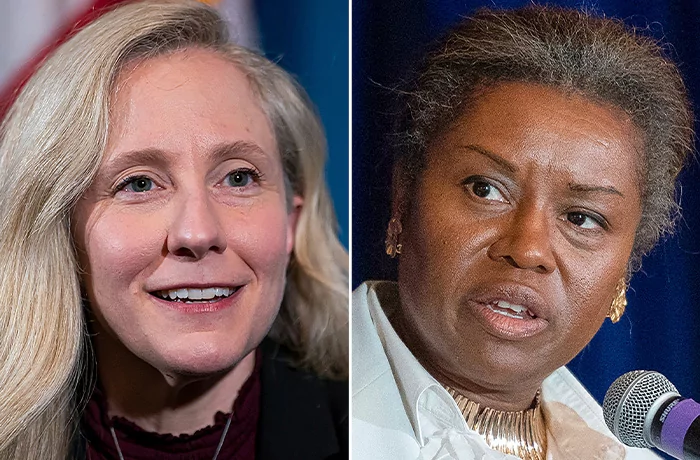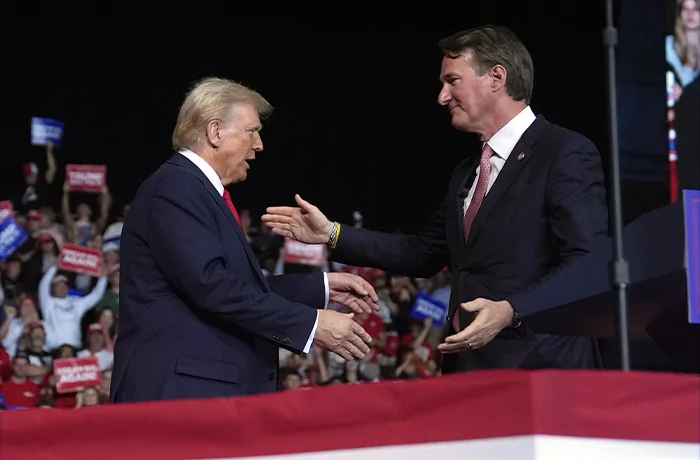Though the Virginia gubernatorial election is more than six months off, it’s shaping up as a crucial indicator of political winds ahead of the 2026 midterm elections and a test of President Donald Trump’s and fellow Republicans’ political strength a year after he won a second, nonconsecutive term.
Virginia and New Jersey are the only states with governor’s races this year. The commonwealth has another distinction — it is the only state where governors aren’t allowed consecutive terms.
Four years ago, Gov. Glenn Youngkin (R-VA), a wealthy private equity executive and political rookie, blocked former Gov. Terry McAuliffe’s comeback attempt after the Democrat had been out of office for nearly four years. Youngkin won the 2021 governor’s race by under 2 percentage points, but it was widely viewed as a repudiation of then-President Joe Biden’s policies and the Democratic congressional majorities at the time.

Voters could make a similar decision this fall, which would be a blow to Trump and Republicans.
“Virginia voters usually rally behind the party that lost the White House in greater numbers when they vote for governor a year later,” Dr. Stephen Farnsworth, the director of the Center for Leadership and Media Studies at the University of Mary Washington, told the Washington Examiner.
One thing that could give Democrats a boost is Trump’s unpopularity. From his bombastic rhetoric and executive orders on tariffs to his attacks on federal judges who rule against him, Republicans know he’s giving critics plenty of political ammunition. Special election results from the early months of 2025 also aren’t encouraging for Republicans. A Democratic-aligned candidate in Wisconsin on April 1 won an open state Supreme Court seat, giving liberals a 4-3 edge on that panel. Weeks earlier, a Democratic state Senate candidate in Pennsylvania won in a Lancaster-area district that has been GOP turf for decades.
Whether those political dynamics continue in Virginia is an open question since Trump’s mixed 2024 performance against Democratic rival Kamala Harris. While Trump lost Virginia by 6 points to the then-vice president, he made an 8-point gain in traditionally deep-blue northern Virginia, where the bulk of voters live, per an elections analysis by the Center for Politics at the University of Virginia.
So both parties have reasons for confidence going into November.
“It’s an environment where the Republicans seem to like what they’ve [been] seeing,” said J. Miles Coleman at the Center for Politics. “Meanwhile, on the Democratic side, you do have this kind of appetite for pushback.”
Not everyone is convinced that Trump’s gains in northern Virginia mean the region will continue in that direction in what’s likely to be a low-turnout off-year election, at least compared to the presidential race less than six months ago.
Former Virginia Republican Gov. Jim Gilmore told the Washington Examiner that the elections “stand on their own feet,” meaning electoral moods shift from season to season. 2024’s presidential election was Trump vs. Harris, while this fall’s will feature new circumstances and new candidates.
Trump will still be a factor in November, particularly his Department of Government Efficiency. Because so many northern Virginians work for the federal government or are contractors, the cuts, or threats of them, could come back to bite state Republicans.

“We don’t yet know the reaction of the northern Virginia electorate to President Trump’s layoffs of federal workers,” observed Gilmore, who was Virginia governor from 1998 to 2002 and, during the first Trump administration, U.S. ambassador to the Organization for Security and Cooperation in Europe.
That could include not only federal workers but also their significant others. Farnsworth said the cuts were energizing people who typically don’t cast ballots.
But November is a long way away, and the ire toward DOGE could dissipate as voters focus on more state issues such as education, which proved to be a winner for Youngkin in 2021.
That likely depends on how the gubernatorial primaries shake out.
For Democrats, it looks like former Rep. Abigail Spanberger will secure the nomination without much of a fight.
Spanberger’s early entry into the 2025 election — she announced her candidacy in November 2023 — helped her quickly clear out the rest of the field. Former Richmond Mayor Levar M. Stoney’s campaign lasted all of five months last year before he shifted to the lieutenant governor’s race. Rep. Bobby Scott (D-VA) mused about jumping into the governor’s race for months but didn’t file by the state’s deadline.
Virginia Lt. Gov. Winsome Earle-Sears (R-VA) is the Republican nominee vying to replace Youngkin. Polls have shown her either tied with or trailing Spanberger. That being said, a vast majority of Virginians have yet to make any decision on November.
Despite getting Youngkin’s endorsement and raising $3.1 million in the first quarter of 2025, she nearly drew two would-be challengers in former state Sen. Amanda Chase and former Del. Dave LaRock. Both portray themselves as more Trump-aligned candidates than Earle-Sears, who called Trump a liability in 2022. That was after the national GOP narrowly won the House but failed to gain a majority in the Senate. The lieutenant governor supported Trump in 2024.
Chase, meanwhile, has regularly called herself “Trump in heels,” while LaRock said he wanted to do a Virginia version of DOGE.
However, both came up short of the necessary signatures to make the Republican gubernatorial primary ballot.
While Coleman said he found Earle-Sears’s previous comments about Trump “interesting,” Gilmore said he believed more MAGA-aligned voters will support Earle-Sears now that she’s the party nominee. Farnsworth warned Republicans not to fly too close to the Trump sun because Virginians picked the Democratic presidential candidate three times over Trump.
The lieutenant governor could look to Youngkin for inspiration.
Youngkin received Trump’s support in 2021 but didn’t rely on it. Coleman said that helped Youngkin with voters who didn’t see him as a caricature of the president. “It was hard to kind of pigeonhole as that,” he noted.
It was a move that bothered Trump, who said in 2022 that Youngkin couldn’t have “won without me.” Youngkin waited until last summer to appear at a rally with Trump.
That doesn’t mean November will be a walk in the park for Democrats.
Spanberger was seen as a more centrist Democrat in Congress compared to House colleagues in her party. She warned then-House Speaker Nancy Pelosi (D-CA) and Rep. Alexandria Ocasio-Cortez (D-NY) in 2020 that the “defund the police” rhetoric damaged the party’s reputation. She felt the same about socialism and said, “We need to not ever use the word … ever again.”
Five years later, Democrats are still debating whether to embrace the progressive policies championed by Ocasio-Cortez or return to a more centrist approach.
Democratic strategist Dan Turrentine, co-host of The Morning Meeting on 2Way, told the Washington Examiner the party needs to be more than “anti-Trump.” He pointed to 2006 when Democrats, including then-Rep. Rahm Emanuel (D-IL) and now-Senate Minority Leader Chuck Schumer (D-NY) developed a six-policy plank for candidates to use.
“The party will have to have something proactive to say,” Turrentine said.
Farnsworth agreed. He said Democrats still haven’t come up with a consistent or unified strategy for dealing with Trump’s policy actions and statements.
TARIFF AGENDA RAISES ECONOMIC PRESSURE ON BIG GOP TAX BILL
Gilmore said that for the sake of Republican chances in November, he hoped Democrats continue fighting over what their party should look like.
“If the Democratic Party continues to be kind of wacky and out of touch, that will help Earle-Sears a great deal with her Republican label,” he said.
Taylor Millard is a freelance journalist who lives in Virginia.























